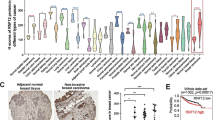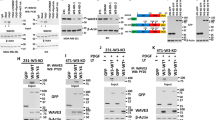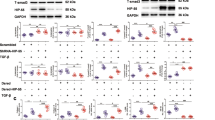Abstract
Transforming growth factor-β (TGFβ) signaling regulates multiple cellular processes, including extracellular matrix production, cell growth, apoptosis and differentiation. Dysfunction of TGFβ signaling has been implicated in various human disorders ranging from vascular diseases to cancer. TGFβ signaling is negatively regulated by the transcriptional repressor TGFβ-induced factor 1 (TGIF1). The tumor suppressor Fbxw7 is the substrate-recognition factor of a ubiquitin ligase that targets multiple proteins for degradation, including c-Myc, cyclin E, c-Jun and Notch. Here, we describe that TGIF1 is targeted for degradation by Fbxw7 in a phosphorylation-dependent manner. Inactivation of Fbxw7 results in the accumulation of phosphorylated TGIF1 molecules and repression of TGFβ-dependent transcription. Cancer cell lines with inactivating mutations in Fbxw7 show enhanced levels of TGIF1 and attenuated TGFβ-dependent signaling. Importantly, inactivation of Fbxw7 attenuates TGFβ-dependent regulation of cell growth and migration. Taken together, our results suggest that Fbxw7 is a novel regulator of TGFβ signaling.
This is a preview of subscription content, access via your institution
Access options
Subscribe to this journal
Receive 50 print issues and online access
$259.00 per year
only $5.18 per issue
Buy this article
- Purchase on Springer Link
- Instant access to full article PDF
Prices may be subject to local taxes which are calculated during checkout




Similar content being viewed by others
References
Bartholin L, Powers SE, Melhuish TA, Lasse S, Weinstein M, Wotton D . (2006). TGIF inhibits retinoid signaling. Mol Cell Biol 26: 990–1001.
Bengoechea-Alonso MT, Ericsson J . (2009). A phosphorylation cascade controls the degradation of active SREBP1. J Biol Chem 284: 5885–5895.
Faresse N, Colland F, Ferrand N, Prunier C, Bourgeade MF, Atfi A . (2008). Identification of PCTA, a TGIF antagonist that promotes PML function in TGF-beta signalling. EMBO J 27: 1804–1815.
Feng XH, Derynck R . (2005). Specificity and versatility in tgf-beta signaling through Smads. Annu Rev Cell Dev Biol 21: 659–693.
Koepp DM, Schaefer LK, Ye X, Keyomarsi K, Chu C, Harper JW et al. (2001). Phosphorylation-dependent ubiquitination of cyclin E by the SCFFbw7 ubiquitin ligase. Science 294: 173–177.
Lo RS, Wotton D, Massague J . (2001). Epidermal growth factor signaling via Ras controls the Smad transcriptional co-repressor TGIF. EMBO J 20: 128–136.
Massague J . (1998). TGF-beta signal transduction. Annu Rev Biochem 67: 753–791.
Massague J, Blain SW, Lo RS . (2000). TGFbeta signaling in growth control, cancer, and heritable disorders. Cell 103: 295–309.
Miyazono K, Suzuki H, Imamura T . (2003). Regulation of TGF-beta signaling and its roles in progression of tumors. Cancer Sci 94: 230–234.
Moustakas A, Heldin CH . (2009). The regulation of TGFbeta signal transduction. Development 136: 3699–3714.
Onoyama I, Nakayama KI . (2008). Fbxw7 in cell cycle exit and stem cell maintenance: insight from gene-targeted mice. Cell Cycle 7: 3307–3313.
Pessah M, Prunier C, Marais J, Ferrand N, Mazars A, Lallemand F et al. (2001). c-Jun interacts with the corepressor TG-interacting factor (TGIF) to suppress Smad2 transcriptional activity. Proc Natl Acad Sci USA 98: 6198–6203.
Rajagopalan H, Jallepalli PV, Rago C, Velculescu VE, Kinzler KW, Vogelstein B et al. (2004). Inactivation of hCDC4 can cause chromosomal instability. Nature 428: 77–81.
Shi Y, Massague J . (2003). Mechanisms of TGF-beta signaling from cell membrane to the nucleus. Cell 113: 685–700.
Strohmaier H, Spruck CH, Kaiser P, Won KA, Sangfelt O, Reed SI . (2001). Human F-box protein hCdc4 targets cyclin E for proteolysis and is mutated in a breast cancer cell line. Nature 413: 316–322.
Sundqvist A, Bengoechea-Alonso MT, Ye X, Lukiyanchuk V, Jin J, Harper JW et al. (2005). Control of lipid metabolism by phosphorylation-dependent degradation of the SREBP family of transcription factors by SCF(Fbw7). Cell Metab 1: 379–391.
Tetzlaff MT, Yu W, Li M, Zhang P, Finegold M, Mahon K et al. (2004). Defective cardiovascular development and elevated cyclin E and Notch proteins in mice lacking the Fbw7 F-box protein. Proc Natl Acad Sci USA 101: 3338–3345.
Tsunematsu R, Nakayama K, Oike Y, Nishiyama M, Ishida N, Hatakeyama S et al. (2004). Mouse Fbw7/Sel-10/Cdc4 is required for notch degradation during vascular development. J Biol Chem 279: 9417–9423.
Wei W, Jin J, Schlisio S, Harper JW, Kaelin Jr WG . (2005). The v-Jun point mutation allows c-Jun to escape GSK3-dependent recognition and destruction by the Fbw7 ubiquitin ligase. Cancer Cell 8: 25–33.
Welcker M, Clurman BE . (2008). FBW7 ubiquitin ligase: a tumour suppressor at the crossroads of cell division, growth and differentiation. Nat Rev Cancer 8: 83–93.
Welcker M, Orian A, Jin J, Grim JE, Harper JW, Eisenman RN et al. (2004). The Fbw7 tumor suppressor regulates glycogen synthase kinase 3 phosphorylation-dependent c-Myc protein degradation. Proc Natl Acad Sci USA 101: 9085–9090.
Wotton D, Knoepfler PS, Laherty CD, Eisenman RN, Massague J . (2001). The Smad transcriptional corepressor TGIF recruits mSin3. Cell Growth Differ 12: 457–463.
Wotton D, Lo RS, Lee S, Massague J . (1999a). A Smad transcriptional corepressor. Cell 97: 29–39.
Wotton D, Lo RS, Swaby LA, Massague J . (1999b). Multiple modes of repression by the Smad transcriptional corepressor TGIF. J Biol Chem 274: 37105–37110.
Wu MY, Hill CS . (2009). Tgf-beta superfamily signaling in embryonic development and homeostasis. Dev Cell 16: 329–343.
Yada M, Hatakeyama S, Kamura T, Nishiyama M, Tsunematsu R, Imaki H et al. (2004). Phosphorylation-dependent degradation of c-Myc is mediated by the F-box protein Fbw7. EMBO J 23: 2116–2125.
Acknowledgements
We thank Ulla Engström for peptide synthesis and antibody purification, and Aris Moustakas, Lars van der Heide and Peter Lönn for plasmids, antibodies and advice. This work was supported by a grant from the Ludwig Institute for Cancer Research Ltd. JE is the recipient of a Science Foundation Ireland Stokes Professorship Award (07/SK/B1242b).
Author information
Authors and Affiliations
Corresponding author
Ethics declarations
Competing interests
The authors declare no conflict of interest.
Additional information
Supplementary Information accompanies the paper on the Oncogene website
Rights and permissions
About this article
Cite this article
Bengoechea-Alonso, M., Ericsson, J. Tumor suppressor Fbxw7 regulates TGFβ signaling by targeting TGIF1 for degradation. Oncogene 29, 5322–5328 (2010). https://doi.org/10.1038/onc.2010.278
Received:
Revised:
Accepted:
Published:
Issue Date:
DOI: https://doi.org/10.1038/onc.2010.278
Keywords
This article is cited by
-
Molecular characterization of sessile serrated adenoma/polyps with dysplasia/carcinoma based on immunohistochemistry, next-generation sequencing, and microsatellite instability testing: a case series study
Diagnostic Pathology (2018)
-
Tumor suppressor Fbxw7 antagonizes WNT signaling by targeting β-catenin for degradation in pancreatic cancer
Tumor Biology (2016)
-
The role of the ubiquitin proteasome system in cerebellar development and medulloblastoma
Molecular Brain (2015)
-
Proteomic screen reveals Fbw7 as a modulator of the NF-κB pathway
Nature Communications (2012)
-
Role of the ubiquitin ligase Fbw7 in cancer progression
Cancer and Metastasis Reviews (2012)



